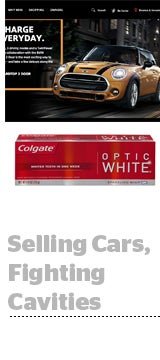 A global consumer packaged-goods giant and specialty automotive company have very different digital aspirations.
A global consumer packaged-goods giant and specialty automotive company have very different digital aspirations.
For toothpaste brand Colgate-Palmolive Co., its target demographic is everyone.
“How many teeth exist in the world?” said Jack Haber, VP of global advertising and digital for Colgate-Palmolive Co., during Simulmedia’s Salon series panel event Thursday with MediaLink.
“For some brands, the focus is algorithmic targeting, but when you have to reach everybody, generally you will target at mass level and then peel off the layers,” he said.
Some of those layers might include products positioned for women who are pregnant or someone with diabetes. “For us, it’s not about the fine targets,” he said. “It’s the right sequence of large targets.”
By contrast, BMW-owned MINI USA markets to driver-enthusiasts.
“Our audience is not a mass audience,” said Lee Nadler, marketing communications manager for MINI USA. “We’re trying to reach less than 1% of the market. It’s not a demographic. It’s an interest and we want to try and attract more people with the MINI mindset.”
MINI doesn’t rely solely on TV buys to reach a mass audience without a concrete goal. Its ad during the last Super Bowl focused on a rebranding of its four-door Cooper Countryman model.
“When we do television, it’s to change awareness and perception of MINI as just a small and cute car,” Nadler said. “TV is much more of a perception play.”
Although MINI used to take a much more linear approach to the sales funnel – begin with TV and segment out and retarget visitors once they hit the MINI site – it’s reevaluating that approach.Because MINI’s TV budget is much smaller than Colgate’s – making it more difficult to fund large branding campaigns – the auto manufacturer maximizes its spend via crowdsourcing at both the agency and client levels. It requires collaboration from its four agencies: creative, CRM, media buying and social.
“I’m one of only five people in MINI USA marketing, so we don’t necessarily have the buying power to go to WPP and ask them to form a buying group for us,” Nadler said.
“We try to be like an accordion – add and take away when we need,” he added. “We have people from each agency sitting in our offices and we’re having hallway conversations instead of [a briefing] at the agency every two weeks.”
This is quite the opposite of Colgate, which works with some of the larger holding company agencies like WPP’s GroupM and MEC to place its media buys. Colgate has shifted its television-buying strategy most around the “big idea.” That is, TV used to be the big idea and now the company begins with the idea and not the medium.
While traditional TV remains the greatest storytelling medium, the CPG brand, like MINI, is evaluating ways digital can support awareness campaigns. One-third of Colgate’s TV budget in China is now dedicated to online video, which supports that notion, but Haber said the brand does not prioritize the channel over the creative.
“There’s so much conversation about data and technology, but what are we actually delivering?” he asked. “What’s the point of knowing you were exposed to my ad if [the message that’s] delivered to me doesn’t move me?”
Despite its emphasis on the creative and building an emotional attachment with moms who may buy Colgate toothpaste monthly for their children, Colgate’s Haber said last-touch attribution remains a challenge for the brand. In some ways, Colgate has an easier time marketing in non-US markets because TV is still the single dominant medium.
In the US, digital video, social media and mobile are arguably in the beginning stages of trumping traditional TV, and the brand has morphed its investments accordingly. While Haber fondly referenced 1950s variety show “The Colgate Comedy Hour,” he acknowledged content creation was not the brand’s specialty, selling toothpaste was.
Contrast that with MINI, which has a program called “MINI as Media,” which in part crowdsources customer content for use in videos, campaign creative and other assets.
In spite of content distribution partnerships with traditional and new media publishers Hearst Men’s Group and BuzzFeed, “with digital, it’s still hard to get great content out there and get seen,” Nadler admitted.














